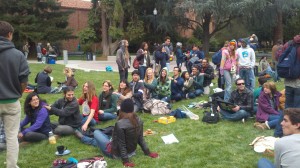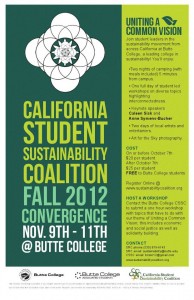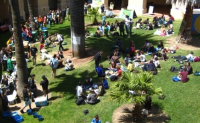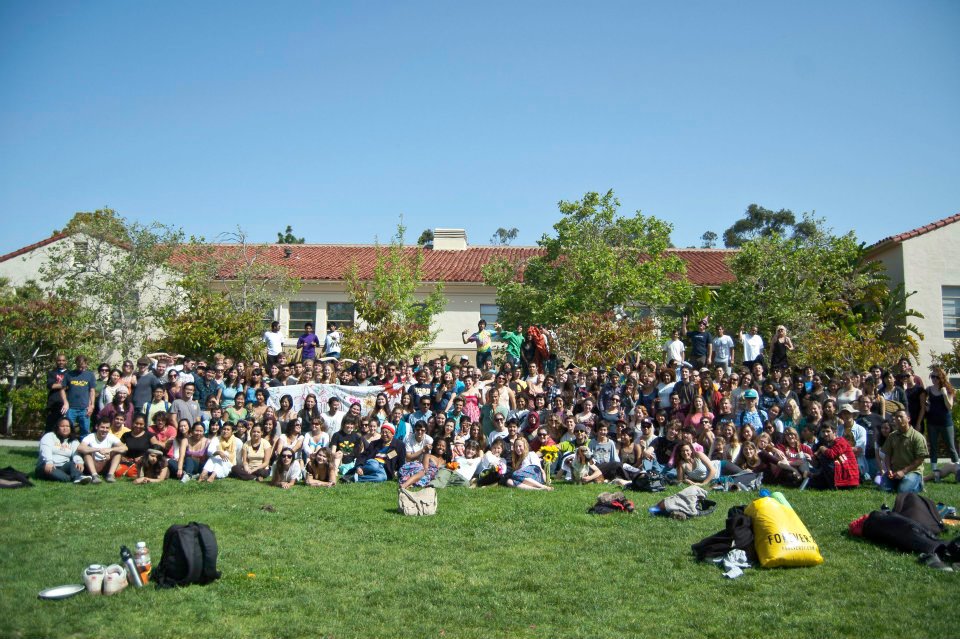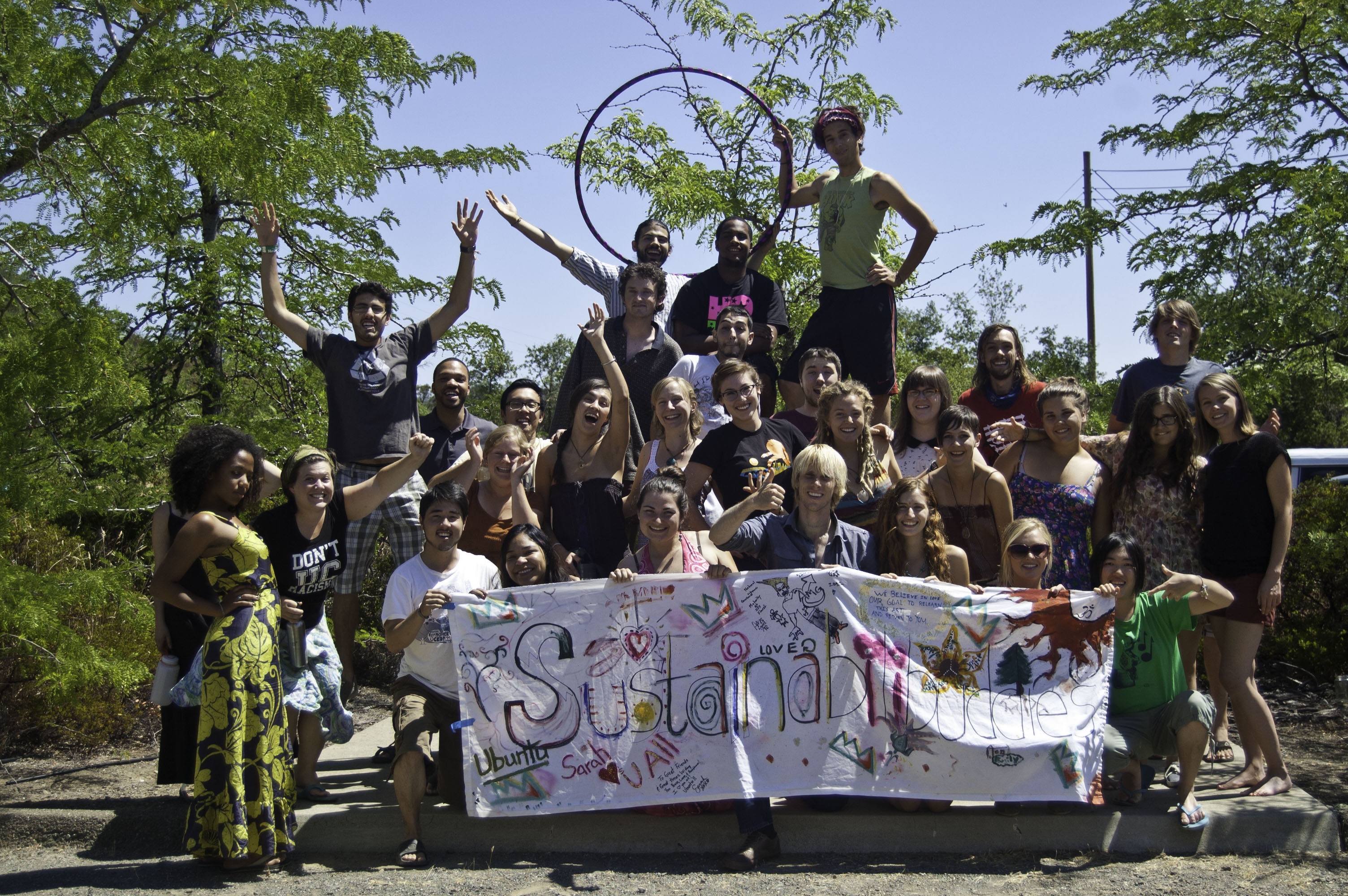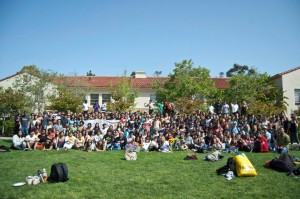A California proposal would offset the state’s climate-altering emissions by paying for forest conservation in Chiapas. Could there be unintended consequences in a region with a history of human rights abuse and land grabs?
re-posted from Yes! Magazine
“We are not responsible for climate change—it’s the big industries that are,” said Abelardo, a young man from the Tseltal Mayan village of Amador Hernández in the Lacandon jungle of Chiapas. “So why should we be held responsible, and even punished for it?”
Image of San Cristóbal, where the GCF meeting took place, by barenuckleyellow, licensed under Creative Commons.
Abelardo was one of dozens of villagers who had traveled to the city of San Cristóbal de las Casas to protest an international policy meeting on climate change and forest conservation. At a high-end conference center, representatives from the state of California and from states and provinces around the world were working out mechanisms intended to mitigate climate change by protecting tropical forests. The group was called the Governor’s Climate and Forests Task Force (GCF), and California’s interest was in using forest preservation in Chiapas as a carbon offset—a means for meeting climate change goals under the state’s 2006 Global Warming Solutions Act.
Such an agreement among subnational governments is unprecedented, and California officials view it as an important way for the world’s eighth largest economy to help the developing world. But judging from the reaction on the streets of San Cristóbal, Mexican peasants see it differently. The lush, mountainous state of Chiapas has a long history of human rights abuses, and the Mexican government has forcibly evicted indigenous families from their lands in the name of environmental protection. To indigenous peasants in the Lacandon jungle, the pending agreement has all the hallmarks of a land grab.
- And such culture clashes over land and forests may become more common: As scientists, economists, and governments worldwide struggle to find solutions to runaway climate change, they are investing in one-size-fits-all financial strategies for emissions reductions in developing countries. These policies tend to ignore local needs, land tenure issues, small-scale economies, cultural practices, and histories. Communities in developing countries are raising concerns that, in some instances, these alleged cures may be worse than the disease.
The GCF was founded in 2009 when 16 states and provinces, from California to Central Kalimantan, Indonesia, and from Cross-River State, Nigeria, to Acre, Brazil, decided to explore ways to implement a program called Reducing Emissions from Deforestation and forest Degradation (REDD). REDD is a program intended to fight climate change by stopping deforestation. Under REDD, the industrialized North hopes to offset carbon emissions by paying the global South to preserve forests (which store carbon). Since its acceptance into U.N. climate negotiations in 2005, the program has grown popular among international agencies and governments interested in funding rural development—and has generated fierce resistance among sectors of the rural poor and indigenous peoples.
When indigenous peasant farmers in Chiapas hear that they’ll be paid to stop growing traditional crops and reforest with African palm trees, they see signs of a familiar pattern. And when they’re told that they may have to leave their jungle villages to allow the forest to recover, they’re acutely aware of the ongoing theft of their lands. In Chiapas, both projects—the planting of biofuel crops and the forced resettlement of forest communities—are linked to the local implementation of REDD.
To indigenous peasants in the Lacandon jungle, the pending agreement has all the hallmarks of a land grab.
Agencies and policy leaders acknowledge the tension, but are sometimes dismissive of the depth of the problem. William Boyd, senior advisor to the GCF and a professor of law at the University of Colorado, said, “Any broad public policy is going to generate opposition. We understand that, and we see the need to do a better job at communicating our objectives.” But the problem is not merely communication. It is an issue of fundamentally different ways of viewing the world. León Enrique Ávila, an agronomist and professor of sustainable development at the Intercultural University of Chiapas, sees REDD as “a continuation of the colonial project to do away with the indigenous worldview.”
Ávila’s work is strongly rooted in the indigenous concept of lekil kuxlejal, or el buen vivir—a complex worldview involving harmony among people, the environment, and the ancestors. According to this way of thinking, people are a part of—not apart from—nature. From this perspective, even apparently benign Western notions of wealth, development, conservation, and sustainability are as alien and as hostile as the more recognized ills of consumerism, individualism, and war.
“REDD and projects of this type,” Ávila said, ignore “that nature [has its own] rights, and treat it as a provider of goods and services, a purely economic entity. This perspective is fundamentally hostile to lekil kuxlejal.”
A closely watched partnership
Of numerous REDD projects worldwide, the agreement between California and Chiapas, expected to come online by 2015, is the most advanced, and was the subject of great interest at the Chiapas GCF meeting. “We are all watching the California-Chiapas project closely,” said Iwan Wibisono of the Indonesian National REDD+ Task Force.
In 2006, California passed the Global Warming Solutions Act, which mandates that the state reduce greenhouse gas emissions to 1990 levels by the year 2020. Under the act’s implementation plan, approved by the California Air Resources Board in 2011, 15 to 20 percent of the state’s mandated emission reductions will come from a cap-and-trade program that regulates the state’s major industrial polluters. The program allows polluters to meet part of their emissions-reduction targets by purchasing carbon credits. Also known as offsets, these let a company pay someone else to reduce CO2 emissions instead of reducing pollution at the source. Currently, the state only allows offsets in the United States. But if the REDD plan goes through, California companies could pay states in some of the world’s most forested regions not to cut down their trees.
As one of his last acts in office, former California Governor Arnold Schwarzenegger signed a memorandum of understanding with Chiapas, opening the door for California industries to buy offsets generated there. (Other states working on similar agreements with California include Acre, Brazil, Aceh, Indonesia, and Cross-River State, Nigeria).
Two years later, the protocols for this agreement are still in development by a non-governmental body called the REDD Offsets Working Group, which is expected to release its recommendations before the end of 2012.
Echoes of history
In preparing for the GCF meeting in San Cristóbal, a number of Chiapas-based civil society groups formed a coalition called REDDeldía (the English translation would be “REDD-ellion,” as in “rebellion”), which held a parallel forum denouncing the GCF and REDD. The group’s statement, issued in advance of the GCF meeting, called REDD “the new face, painted green by the climate crisis, of an old and familiar form of colonialism that advances the appropriation of lands and territories through dispossession and forced displacement.” That sentiment was echoed by a similar forum convened in San Cristóbal the same week by La Vía Campesina, the world’s largest federation of peasant farmers.
- For groups in Chiapas, these concerns are rooted in recent local history. In 1971, the Mexican government issued a decree that gave about 1.5 million acres of the Lacandon jungle to the Lacandon Maya—one of several ethnic groups that call the region their home—while retaining the rights to exploit timber, minerals, and other resources. A second decree in 1976 made the greater part of the jungle—the area with the richest biodiversity in Mexico—into a UNESCO World Heritage site called the Montes Azules Biosphere Reserve.
Along with a few settlements from the Tseltal and Ch’ol ethnic groups, who negotiated their way into the agreement, the nominal owners of this territory were designated “the Lacandon Community.” But the creation of the Lacandon Community came with a political cost: in order to give the Lacandon Maya 1.5 million acres of forest, 26 villages of Tseltal and Ch’ol people—over 2,000 families who had lived there for decades, if not centuries—had to be moved.
After their expulsion, several peasant farmer organizations demanded redress, and the resulting tension between the Lacandon Community and its neighbors made it impossible, for decades, for the Mexican government to successfully demarcate the territory. The demarcation line became known as la brecha Lacandona—“brecha” meaning split, schism, or gap. Some of the expelled communities later coalesced to form the Zapatista Army of National Liberation, the indigenous rebel group that brought Chiapas to the world’s attention with their 1994 uprising. Among the proto-Zapatistas and the other peasant farmer groups in the region in the 1970s, one of the primary political slogans was “No to la brecha Lacandona!”
With REDD, work is underway again to draw la brecha Lacandona. In February, 2011, Chiapas Governor Juan Sabines began distributing payments of 2,000 pesos a month to members of the Lacandon Community as part of the state’s Climate Change Action Program, and the state began expelling “illegal settlers” from the Montes Azules Reserve.
“The jungle was previously occupied by over 900 communities,” Sabines told the GCF at the opening plenary. “Now we have cleared them from the jungle. Today the Reserves are being conserved and protected by their legitimate owners, who will soon have access to the carbon markets.”
Among the communities slated for removal from the jungle is the village of Amador Hernández—1,500 Tseltal Mayan subsistence farmers who escaped plantation servitude in the 1950s to make their homes in bare wooden huts and cultivated scattered cornfields in the area that is now the Montes Azules Reserve. On the first day of the three-day GCF meeting, several campesinos from Amador Hernández and neighboring communities entered the auditorium and requested a few minutes at the microphone. ChiapasState Minister of the Environment and Natural History Fernando Rosas denied their request, telling the community members that they should listen first to the meeting’s proceedings. If they wanted to consider joining the REDD program, the minister told them, he would meet with them at a later date.
Unsatisfied, the campesinos mounted a protest. They handed out flyers declaring, “The government is lying to you—they have neither informed us nor consulted us!” Eufemia Landa Sanchez, a woman from a deforested region on the edge of the Montes Azules Reserve, then took the microphone and read a message to the plenary.
“Transnational businesses have had plans for the rural areas of Chiapas for some time now,” Sanchez said. “The natural wealth of biodiversity and water, of mines, of biofuels, and of course of petroleum, have led to the displacement of people, the poisoning of the earth, and have made the peasant farmer into a serf on his own land. And in every case they blame us and criminalize us. Our supposed crime today is that we are responsible for global warming.
“Why do the wealthy want to impose their will by force?” she continued. “The jungles are sacred, and they exist to serve the people, as God gave them to us. We do not go to your countries and tell you what to do with your lives and your lands. We ask that you respect our lives and our lands, and go back where you came from!”
Hanging in the balance
Insiders in the GCF projected that, given the complexities of linking an emerging market in California to forested lands abroad, and the level of controversy in Chiapas, the Chiapas-California plan has no better than a 50/50 chance of coming to fruition. Aside from the 2010 agreement, no formal protocols have been approved by the two states. And, aside from a $1.5 million grant to the GCF from the U.S. State Department and hope that a so-far hypothetical carbon market will provide some stable cash flow, little funding is on the horizon.
“If we can’t build a $6 million fund to make this happen, then we’ve got to think about other options,” said Boyd. “Among these options, we’re looking at innovative models for leveraging private sector investment.”
After enduring years of toxic dumping and rising cancer rates, indigenous Ecuadorians took oil giant Chevron to court to fight for the life of the rainforest—and its people.
Three weeks after the Chiapas GCF meeting, the California Air Resources Board (ARB) received a visit at its Sacramento office from a group of environmental justice advocates with ties to the Global South—including an anthropologist who works closely with Amador Hernández, an indigenous leader from Brazil, and representatives of Friends of the Earth U.S. They drew a picture of land grabs, government repression, and related abuses, and urged state officials to drop all consideration of international forest offsets in California climate policy.
Edie Chang, assistant division chief for the ARB, thanked the visitors for raising the issues, and assured them, “We’ve told these governments that we’re far from making a decision.”
Jason Gray, the ARB’s staff counsel, acknowledged the concerns as well: “We really only want to work with jurisdictions that engage in consultation and participatory processes. … We understand the political risks. … We would only want to be involved if California can take a leadership role.”
What that leadership looks like remains to be seen. But if land and culture are threatened by any policy advanced by the GCF, indigenous peasant farmers in Chiapas will not back down without a fight. “These campesinos don’t want a revolution to change they way they live,” explained León Ávila, echoing the words of Mexican revolutionary Emiliano Zapata. “They want a revolution because they want to continue living as they always have.”
 Jeff Conant wrote this article for What Would Nature Do?, the Spring 2013 issue of YES! Magazine. Jeff is author of A Community Guide to Environmental Health and A Poetics of Resistance: The Revolutionary Public Relations of the Zapatista Insurgency. He writes for Alternet, Earth Island Journal, Upside Down World, and Z Magazine.
Jeff Conant wrote this article for What Would Nature Do?, the Spring 2013 issue of YES! Magazine. Jeff is author of A Community Guide to Environmental Health and A Poetics of Resistance: The Revolutionary Public Relations of the Zapatista Insurgency. He writes for Alternet, Earth Island Journal, Upside Down World, and Z Magazine.
Interested?
Editor’s Note: This post was originally published by YES! Magazine, and is licensed under Creative Commons. To repost, follow these steps.
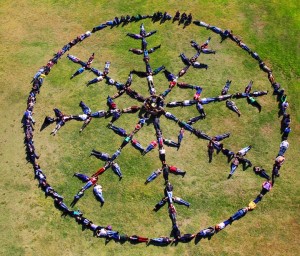
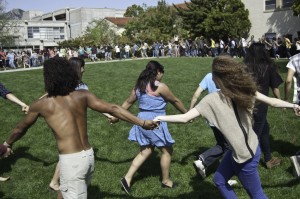



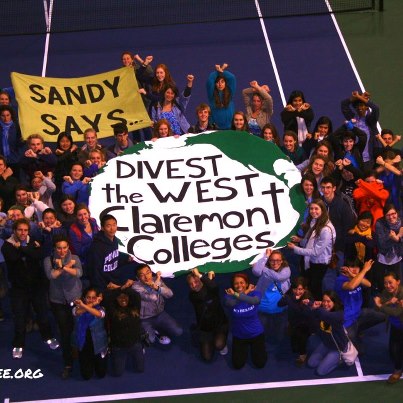
 Jeff Conant wrote this article for
Jeff Conant wrote this article for 